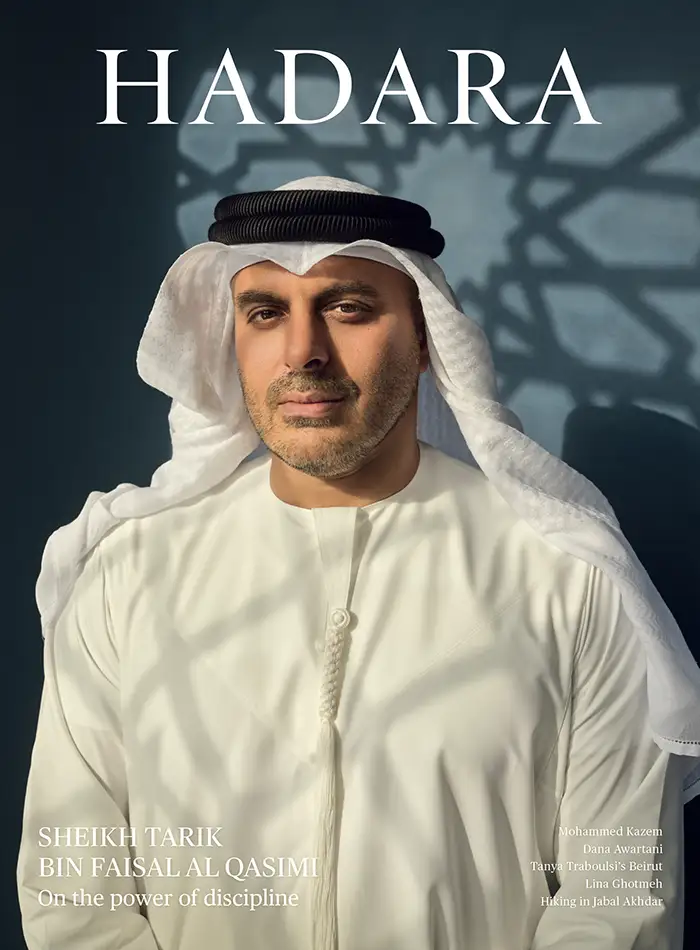A Witness to History
The Palace Hotel in Jerusalem is a metaphor for the Palestinian dream.
By Nadi Abusaada
On the edge of Jerusalem’s Old City, less than a kilometre from Jaffa Gate, a building stands as testament to an important chapter in the city’s history. Adorned with an ornate stone façade, Andalusian-style windows and arches, and featuring a gracefully curved entrance, the Palace Hotel marked a grand era in Palestinian-led construction during the British Mandate years. Built in 1929, it has weathered a tumultuous history, mirroring the fate of the nation it was born to serve.
The Palace Hotel can be traced back to an earlier initiative. In 1922, the Supreme Muslim Council in Palestine, under the leadership of Hajj Amin al-Husseini, grand mufti of Jerusalem and an Arab nationalist, initiated substantial renovations to the Haram al-Sharif complex in the Old City. Overseen by renowned Turkish architect Ahmet Kemaleddin and local architect Rushdi Imam al-Husseini, the project sought to restore the historical site.
But as works progressed, Council funds were directed to a new venture beyond the Old City—the Palace Hotel. Originally conceived as an apartment complex, plans were drafted by Rushdi Imam al-Husseini and later refined by Turkish architect Mehmet Nihat Nigizberk. On completion the Palace Hotel became one of Jerusalem’s most luxurious addresses, boasting an impressive entrance hall, marble arabesque decoration, and modern amenities.
It fused architectural and artistic mastery. Two pioneering Jerusalem artists played key roles in shaping the hotel’s distinctive decoration. Haifa-born artist Jamal Badran, who was also involved in the reconstruction of Al-Aqsa Mosque, provided drawings for the stone carvings on the façade. Armenian ceramicist David Ohannessian, who changed the face of Jerusalem with his ceramic workshop, contributed tiles that adorned the hotel’s interior spaces and courtyard fountain.
In 1933 and 1934, the hotel played an important role as the venue for the Arab Exhibitions. Events of profound significance, they reinstated the region’s historical bond following the division of the World War. They showcased works of art, craft, and industry from across the Arab world—soaps from Nablus, Damascene textiles and perfumes from Tripoli. The hotel’s spacious design proved advantageous. Guest rooms became exhibition booths, public areas housed displays of textiles and antiquities, and the courtyard’s large hall became a stage.
During the fairs, the hotel garnered significant coverage in the Arabic press. Despite its eclectic architectural design, exhibiting Greco-Roman, Andalusian, and Ottoman influences, newspapers hailed it as an “Arab-style” building, symbolising the Arab cultural renaissance and reflecting the growing influence of Arabism on various aspects of life.
However, enthusiasm soon waned as the hotel encountered financial challenges, intensified by competition from the nearby King David Hotel, opened in 1931. In 1936, the building was leased to the British for government offices. The Peel Commission, tasked with investigating the 1936 Great Revolt, held its meetings there. These drew the outlines for the 1937 Partition Plan for Palestine. A building designed to embody Palestine’s national aspirations was now the base for its colonial administration and division.
The 1948 Nakba and its aftermath halted the prospect of Palestinian reclamation of the Palace Hotel. The neighbourhood fell under Israeli control, and like many Palestinian properties it was confiscated. Over the years, the Palace Hotel served various functions for the occupation government, housing ministries and institutions.
In 2008, Hilton Hotels took over the Palace Hotel. A six-year “renovation” ensued that largely erased the original structure. Relaunched as a Waldorf Astoria, it opened in 2014, leaving only the original curved stone facade intact. Remnants of the original Palace Hotel—including the ceramic works of David Ohannessian—were looted and sold at auction.
While so much was erased, a plaque on the building’s façade remains and bears witness to its forgotten history. In Arabic, citing an Umayyad-era poem, it says, “Just as our forefathers built and did, we build and we do. This lodge was built by the Supreme Muslim Council in 1929.”
Nadi Abusaada has an installation based on the history of the Palace Hotel in the group exhibition Guest Relations at Jameel Arts Centre until April 28.
Photograph courtesy of the United States Library of Congress Prints and Photographs Division



